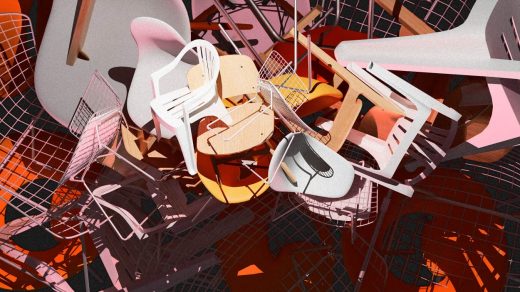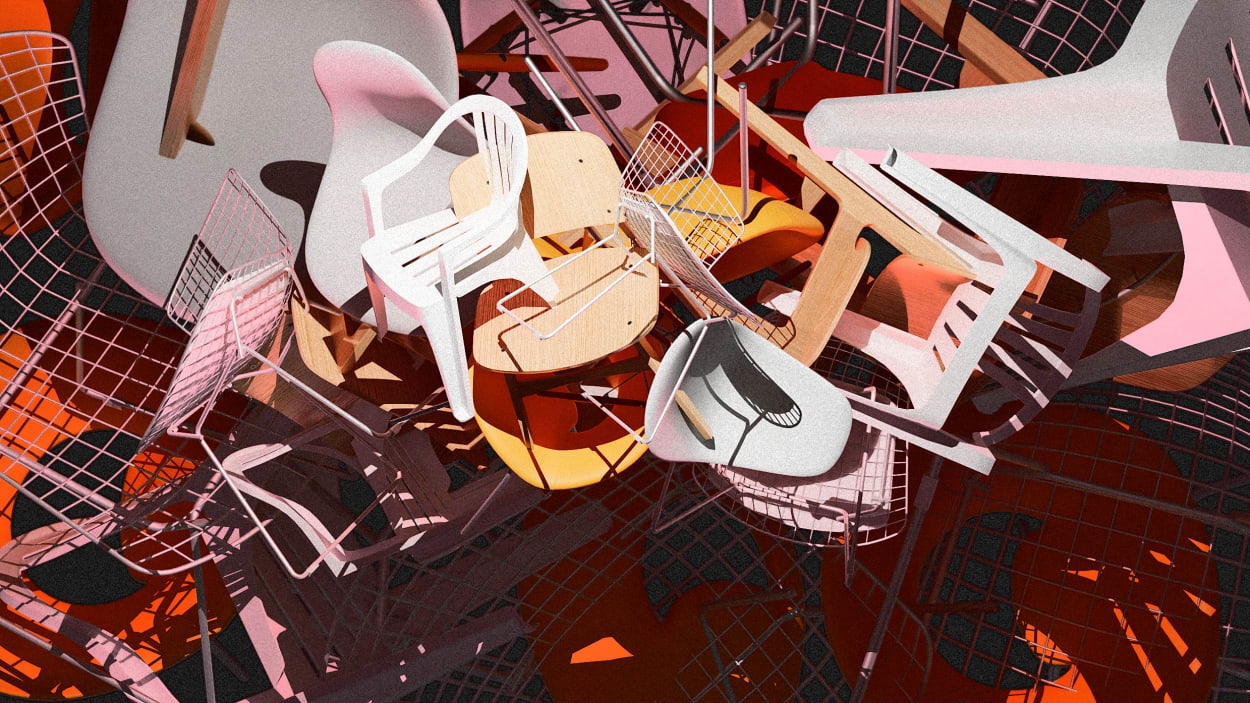Does the world really need another chair?
The Thonet chair. The Wassily Chair. The Eames Lounge Chair. These chairs have gone down in history as design icons—engineering masterpieces that have changed the way we make, shape, package, or ship furniture. But for every legendary chair, there have been 1,000 forgettable ones. Unabashed knockoffs. Old chairs, repackaged as new chairs. Event chairs, office chairs, lounge chairs, restaurant chairs. And . . . Too. Many. Plastic. Chairs.
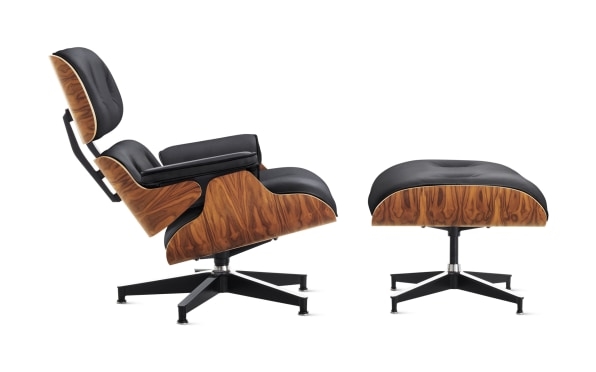
As we head into the Milan Furniture Fair (Salone del Mobile Milan)—a veritable cornucopia of seating options—it felt like a good time to ponder a question that’s been brewing in my mind for years: Do we really need yet another chair?
In a world plagued by climate change (which partially can be blamed on humanity’s propensity for excessive consumption), why do designers continue to pour their creative energy into the umpteenth incarnation of an object with four legs and a back?
The adverse effects of fast furniture have been well documented by now. I have no doubt that every informed furniture designer and manufacturer knows that Americans throw out more than 12 million tons of furniture a year, and that only a fraction of that gets recycled, resulting in clogged landfills. Much reporting has been done on the devastating carbon footprint of fast furniture, its impact on deforestation, and the dysfunctional supply chain it relies on.

And yet, we are awash in new chairs. This year, the Salone is showing dozens and dozens of new chairs. In fact, in the lead-up to the fair, I received so many “new chair” announcements that I began fantasizing about a furniture deity issuing a moratorium or mandate that designers find something—anything!—else to obsess over.
Haven’t we reached peak chair, I thought? Isn’t it possible that we’ve designed every possible configuration of a chair there was to design? That we’ve experimented with every material, every color, every shape? If the most sustainable buildings are the ones that already exist, then shouldn’t the most sustainable chairs be the ones that already exist?
After speaking with a few experts, some of my questions have been answered, but I’ve found myself in the middle of a self-debate. Is the chair a symbol of excess or a totem of design genius? And are the two mutually exclusive?
Point: Chairs are valuable symbols
In their seminal book, 1000 Chairs, authors Charlotte and Peter Fiell, who have authored 60 books on the history, theory, and criticism of design, write: “Apart from possibly the automobile, the chair is the most designed, studied, written about and celebrated artifact of the modern era.” Indeed, 1000 Chairs joins a long list of books, exhibitions, and articles that explore the humble seat.

So, what is it about a chair that continues to fascinate designers and preoccupy researchers? For one thing, the chair so perfectly encapsulates the thoughts, values, and philosophy of its designer, says Peter Fiell, who recently joined me on a video call together with his wife and coauthor, Charlotte Fiell. Peter referenced the British architect Peter Smithson, who in 1986, suggested that Mies van der Rohe never designed a city but the architect’s vision for a metropolis was implicit in his Barcelona Chair, a modernist creation known for its stark simplicity and the embodiment of Mies’ famous maxim, “Less is more.”
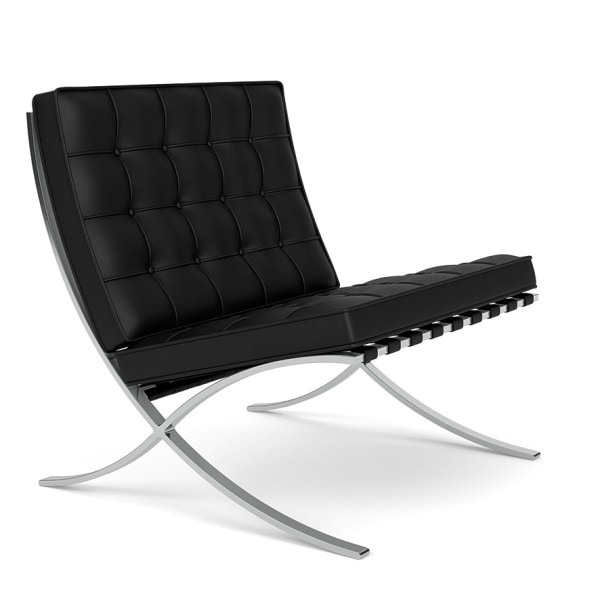
Peter argues that the chair, as an object, is far more accessible (and affordable) than a building. It’s a way to more readily disseminate a designer’s ideals. “As far as conveying ideas goes, you could do that more readily, to more people, more frequently, through a chair as a three-dimensional argument about what’s important to you, than the number of people who could use or even knew your damn building,” he says.
Mapping grander visions onto the simple aesthetic of a chair feels like an overreach, but given the number of famous architects who have designed seating (Wright! Le Corbusier! Eero Saarinen!) there’s some merit to the idea that a chair is capable of communicating broader ideas about the state of design.
Counterpoint: Chairs perpetuate trends
For every innovator, though, there is a perpetrator. And if you find yourself wandering the Rho Milan Fairgrounds this week, thinking to yourself, I’ve seen that chair before, that’s because furniture design is like fashion: It feeds off trends. Peter Fiell references a period of time, about 15 years ago, when everywhere you looked, there was a transparent polycarbonate chair inspired by Philippe Stark’s Louis Ghost, for Kartell. “For the next three, four, five Milans, all you saw on each and every stand were a range of transparent polycarbonate chairs,” he says. In other words, designers wasted their creative energy and contributed to the mass production of even more furniture—all in the name of cloning someone else’s design.
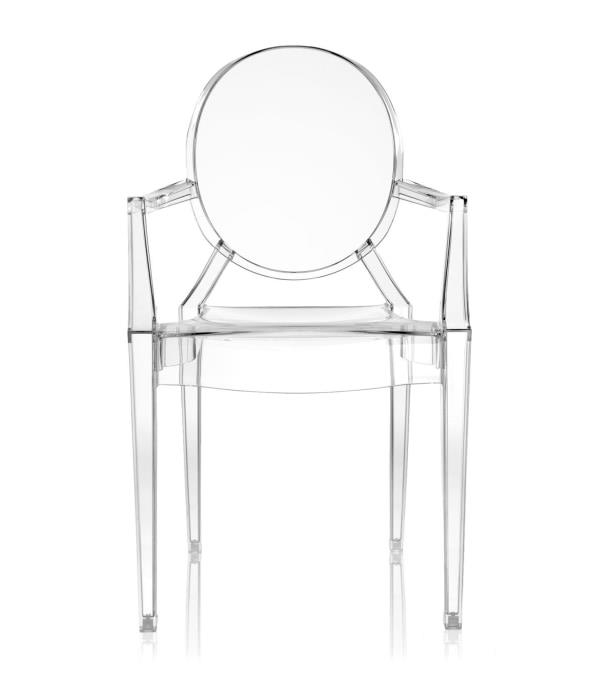
But this tendency to riff on, or downright copy, old models isn’t exactly the designer’s fault, says Peter. Unlike the publishing industry, where writers pitch ideas to book publishers, he says, it’s rare for a designer to come up with a chair design and pitch it to a manufacturer. Typically, it’s the other way around.
“It’s the sales guys sitting around saying, ‘We’ve identified a need for a new, I don’t know, bar stool,’” says Peter. But a bar stool isn’t what the public needs, or even wants; it’s what the company needs to make money. And once the new bar stool has been identified as a potential revenue driver, the manufacturer will mine the industry for successful precedent—a designer who’s already earned their stripes and proven their worth—resulting in an infinity room of chairs.
Point: Chairs champion innovation
Before the industrialization of the 19th century, chairs were largely handcrafted pieces of furniture. The Thonet Chair No. 14, designed in 1859 by German-Austrian cabinetmaker Michael Thonet, is considered to be the first mass-manufactured chair. Since then, chair design has been intrinsically linked with technological advances and material innovation.
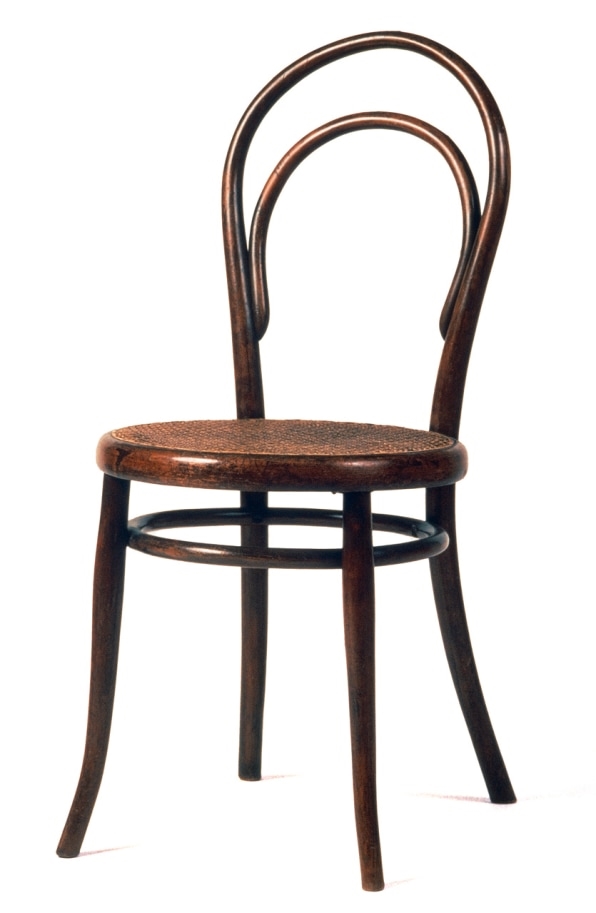
In the 1950s, the American industrial designer George Nelson summed up this symbiotic relationship when he said: “Every truly original idea—every innovation in design, every new application of materials, every technical invention for furniture—seems to find its most important expression in a chair.”
You can see this rationale in the Thonet Chair No. 14, also known as the “bistro chair,” which is comprised of 6 pieces of wood, 10 screws, and 2 nuts, and was the first piece of furniture designed to be shipped in parts. Another example is Verner Panton’s Stacking Chair, designed a full century later, in 1960, as the first single-form, single-material, injection-molded chair.
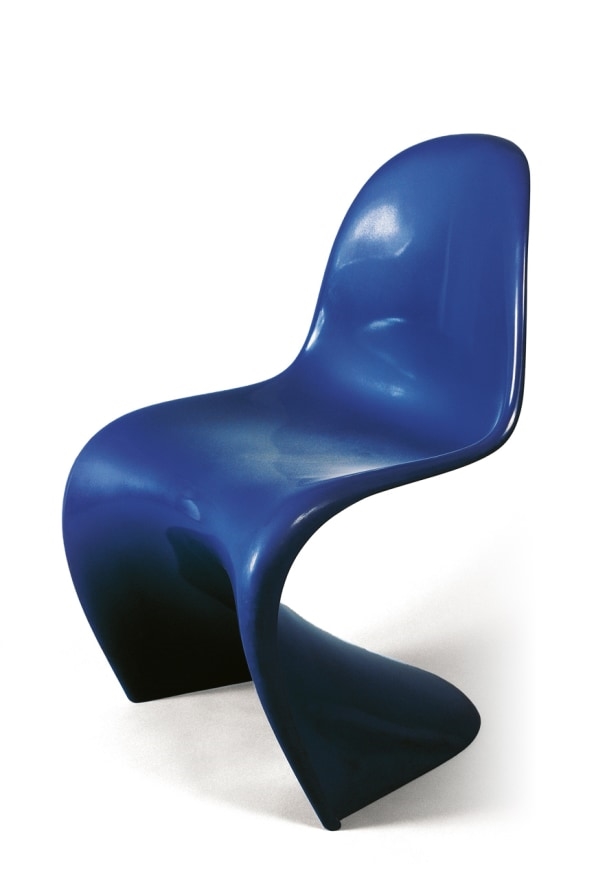
By this logic, a chair can be seen as a vital tool that allows manufacturers and designers to push the boundaries of material and manufacturing capabilities. More recently, various designers have used the humble chair as an investigation tool. These include the Italian designer Martino Gamper, whose 100 Chairs in 100 Days project explored the potential of reused parts and recycled materials. Or the furniture startup Hygroshape, which examined the power of computation to make a flat piece of wood unfurl into a chair in just 12 hours.
Counterpoint: Chairs are inherently unsustainable
If retrofitting a chair to a fabricated market need doesn’t sound like a good reason to design a new chair, that’s because it’s not. But as I listened to the Fiells, I couldn’t help but wonder: What is a good reason to design a chair? According to a 2017 study published in Science Direct, furniture is responsible for around 10% of a building’s greenhouse gas emissions. Every manufacturer, every designer, who puts into the world a new line of chairs (or any kind of furniture, for that matter) has the responsibility to think before they act.
For the Fiells, as long as designers are experimenting with new technology, or exploring a new material, there is room for chair innovation. Peter recalls Jasper Morrison, who in 1999, revolutionized injection molding by injecting gas inside a hollow plastic frame and designed the now famous Air Chair.
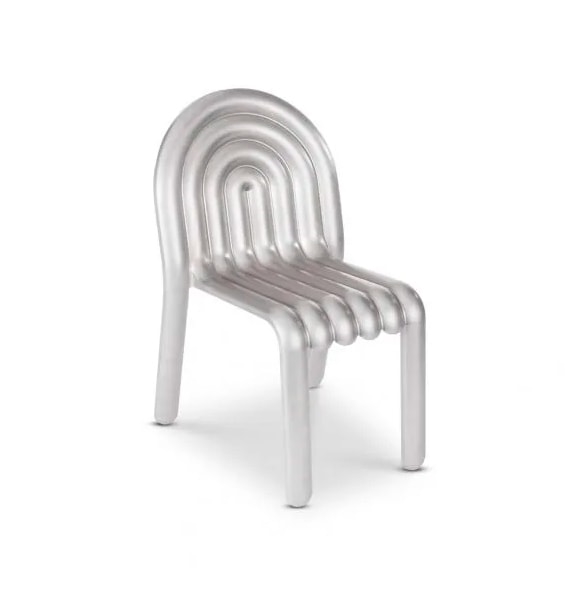
More recently, Tom Dixon innovated on aluminum by blow-forming (or “superplastic forming”) the material at high temperatures, then laser cutting it—resulting in the limited-edition Hydro Chair.
But most material experiments today are not doing enough to push the sustainability ball forward. Yes, chairs like Dixon’s are a testing ground for material innovation, but they can’t make a big enough impact unless they’re produced at scale. And until we see the West Elms and Wayfairs of the world adopting a balanced, thoughtful approach to furniture innovation, these chairs, however groundbreaking, will remain a drop in the ocean.
Point: Chairs are a peek into the future
That’s not to say designers shouldn’t try to push things forward—and increasingly, they are. “The next big benchmark will be in materials technology,” says Peter. “And it will be a material that is already invented, that can be used as replacement for plastic, that is totally and utterly regenerative, so after the chair is deemed no longer usable, you basically plant the chair in the garden, and it helps things grow.”
As it so happens, a chair matching this exact description is actually making its debut at Salone this week. Designed by M4 Factory and Prowl Studio, the Peel chair was created to be biodegradable and compostable. It’s made of hemp-based bioplastic, a material developed by M4 Factory that combines biopolymers with byproducts of industrial hemp processing that are typically wasted. It comes with an injection molded frame (also made of hemp) and hemp foam cushions encased in hemp bioleather. “Everyone goes to Salone with a chair,” says Patricia Miller, founder and CEO of M4 Factory. “And we wanted to provocatively showcase something different and with a different lens of the end in mind.”

Miller says that both the frame and the cushions can be composted at home—6 months for the frame, 3 to 6 weeks for the cushion. But since only 27% of people in the U.S. have access to some form of composting program, she envisions a take-back program that would allow people to ship the chair back when they no longer need it, so it can composted industrially. In Milan, visitors can catch a glimpse of this journey at Alcova’s new venue (the former Porta Vittoria abattoir), where the installation will portray the chair’s transition from its flat-packed version inside hemp packaging to it decomposing in soil.
For now, the chair is just a prototype, and there’s more work to be done before the Peel can be commercialized, including rigorous testing to determine its exact lifespan. (Miller says “it can last as long as it needs to.”) But it’s an intriguing proof-of-concept that pushes the envelope of sustainability further than it’s been pushed before.
And that, I have come to learn, is the power of a chair. Yes, the market remains saturated with chairs—completely and utterly impregnated with them. But sometimes, it’s not about the chair. It’s about what the chair stands for. If only the majority of designers and manufacturers hadn’t lost sight of that.
(18)

